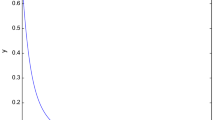Abstract
Einstein aimed to find a unified theoretical model to explain various interactions in nature, and the relationship between gravitational and electric fields was particularly important. For the first time, this paper provides the internal relationship equations of the electric and magnetic fields. Further, the relationship between the magnetic and gravity fields is analyzed, and the relationship equations of the electric, magnetic, and gravity fields are established. On this basis, a general formula for calculating the radius of charged particles is derived. Simultaneously, we also discussed and made predictions on black holes, providing convenience for future research and experimental detection.
Similar content being viewed by others
References
Einstein, A., 1921, A Brief Outline of the Development of the Theory of Relativity; Nature, 106, 782–784.
Zhang, N.S., 1987, Particle physics [Volume one]; Science Press, Beijing, 153–154.
Zhang, Y.M., and Qi, B.Y., 1997, Electromagnetism; China University of Science and Technology Press, Hefei, 246:501:509:506:14:519:229:230:220.
Ding, R.P., 2017, On the Essential Relation of Particle Energy, Mass and Charge and Its Extended Meaning; Journal of Hunan Industry Polytechnic, 4, 24:23.
Einstein, A., 2018, The Collected Works of Albert Einstein. volume [I]; The Commercial Press, Beijing, 207:186–187.
Zhao, Z., 2000, Black holes and curved spacetime; Shanxi Science and Technology Press, Taiyuan, 162–167:274–279.
Bekenstein, J. D., 1995, Novel “no-scalar-hair” theorem for black holes, Phys. Rev. D 51, R6608.
Carroll, S., 2014, The search for the Higgs particle; Hunan Science and Technology Press, Changsha, 50–51.
Ni, G.J., Wang, Y.S., and Qian, J.H., 1998, The physics that changed the world; Shanghai. Fudan University Press, 477:448:475.
Zhou, S.X., 1999, Tutorial on quantum mechanics; Peking. Higher Education Press, 211–216.
Zhang, N.S., 1987, Particle physics [Volume two]; Science Press, Beijing, 17–19.
Ding, R.P., and Qiu, R.F., 2019, A New Model for Explaining Nuclear Forces and Its Extension Meaning; Journal of Hunan Industry Polytechnic, 5, 19–22.
Acknowledgments
This research was partly supported by the Hunan Provincial Natural Science Foundation (No. 2016JJ3034). Thanks to Dr. Liang Xiang-Jing, senior engineer Long Gang, Hunan Industry Polytechnic, who participated in the discussion and gave suggestions. Thanks to Han Yi-Fan, Executive Editor, and anonymous review experts for their pertinent review opinions.
Author information
Authors and Affiliations
Corresponding author
Additional information
This work was supported by the Hunan Provincial Natural Science Foundation(No. 2016JJ3034).
Ding Rong-Pei is a Senior Engineer who completed his undergraduate and master’s degrees at Hunan University in 1994 and 1998, respectively. At present, he is engaged in teaching and research work at Hunan Institute of Technology. His main research interests include applied physics, the application of electromagnetism in particle physics, field theory and cosmology. Email:drp582@163.com
Rights and permissions
About this article
Cite this article
Ding, RP., Zhu, ZH. A new model for describing black holes based on the essential relationship between electric field and gravitational field analysis. Appl. Geophys. (2024). https://doi.org/10.1007/s11770-024-1098-3
Received:
Revised:
Published:
DOI: https://doi.org/10.1007/s11770-024-1098-3




